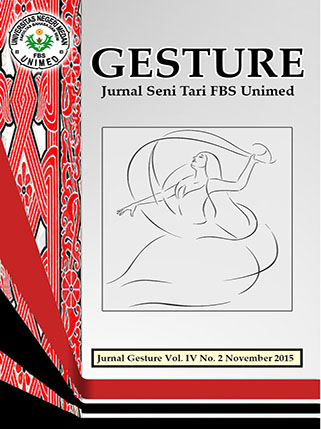BENTUK PENYAJIAN TARI SARAH HADRALMAUT PADA MASYARAKAT MELAYU DI DESA NAGUR KABUPATEN SERDANG BEDAGAI
DOI:
https://doi.org/10.24114/senitari.v4i1.2665Keywords:
Seni Tradisi, Sarah Hadralmaut, MelayuAbstract
Sarah Hadralmaut dance comes from Hadralmaut society those are right now known as Yemenite. It is exactly in the southern peninsula of Arabic. This dance has its own characteristic in the legs movements; it is almost like Zapindance. The purpose of this research is discussing about the presentation form of Sarah Hadralmaut dance to the Malay society at the NagurBedagai village in district of SerdangBedagai. Based on the result that had been done, it can be known that Sarah Hadralmaut dance is a dance that comes from Hadralmaut area or it can be known as Yemenite - in the southern peninsula of Arabic. This dance is more dominant with the legs movement, while arms movement will adjust with the legs steps. This dance is almost the same with Zapin dance because both of them are comin from the same country that is Yemenite. Sooner or later this dance will be inherited by Malay and become characteristic and identity of Malay . It was used to be danced by men only, but right now women are also allowed to dance.Downloads
Published
2015-09-10
Issue
Section
Articles
License
Copyright (c) 2015 Purnomo S

This work is licensed under a Creative Commons Attribution-ShareAlike 4.0 International License.
Authors published with the Gesture: Jurnal Seni Tari agree to the following terms:
- Authors retain copyright and grant the journal the right of first publication with the work simultaneously licensed under a Creative Commons Attribution License (CC BY-SA 4.0) that allows others to share the work with an acknowledgment of the work's authorship and initial publication in this journal.
- Authors are able to enter into separate, additional contractual arrangements for the non-exclusive distribution of the journal's published version of the work (e.g., post it to an institutional repository or publish it in a book), with an acknowledgment of its initial publication in this journal.
- Authors are permitted and encouraged to post their work online (e.g., in institutional repositories or on their website) prior to and during the submission process, as it can lead to productive exchanges, as well as earlier and greater citation of published work. (See The Effect of Open Access)

